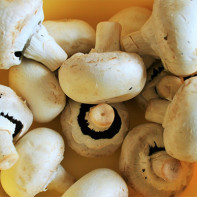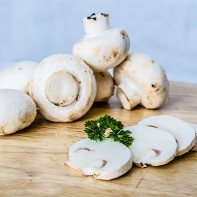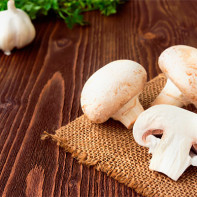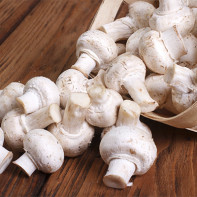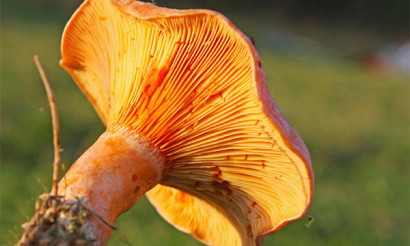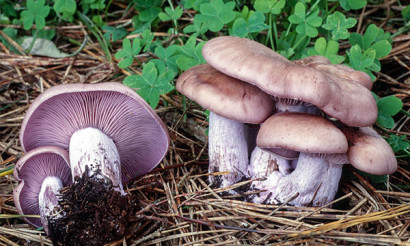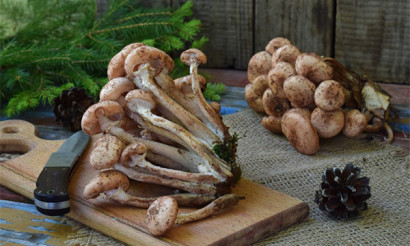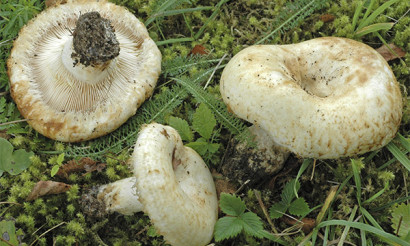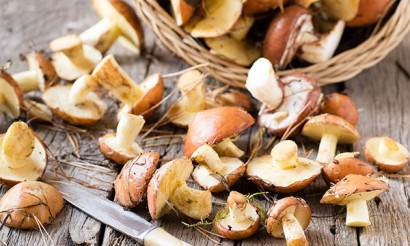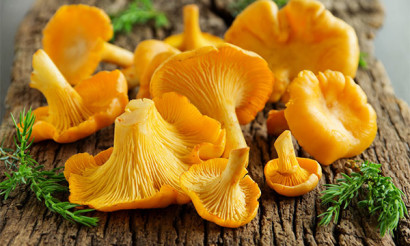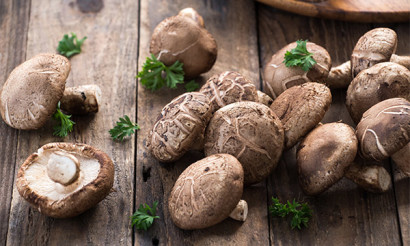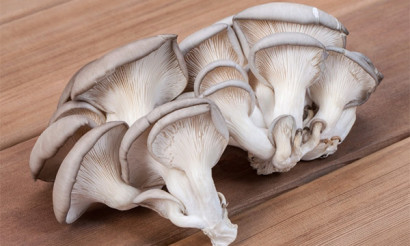Champignons: benefits and harms to the body
Champignon is considered one of the most popular mushrooms among culinary specialists and is cultivated in more than 70 countries. History is silent about the exact time of "domestication" of these mushrooms. But it is known that starting in 1754, mushrooms began to be grown in greenhouses.
- How mushrooms look and where grow
- Kinds
- Pale toadstool and champignons: similarities and differences
- Composition and calorie content
- What are the benefits of champignons
- General benefit
- For women
- For men
- During pregnancy
- When breastfeeding
- For kids
- Can I eat champignons when losing weight
- Champignon mushrooms in medicine
- With diabetes
- With pancreatitis
- With gastritis
- With gout
- With cholecystitis
- Harm and contraindications
- Is it possible to poison mushrooms
- How to choose and store champignons
- Is it possible to freeze
- How to cook champignons: recipes
- How to fry
- How to boil
- Champignon mushroom caviar
- Champignon barbecue
- How to cook mushrooms in the oven
- How to cook champignon soup
- How to pickle
- Do I need to clean the mushrooms before cooking
- How to eat champignons
- Is it possible to eat darkened
- Is it possible to eat raw
- Is it possible to give champignon mushrooms to animals
- Interesting facts about champignons
How mushrooms look and where grow
Champignons have white or brown hats with a diameter of about 10 cm, in shape resembling a hemisphere. The hat is velvety, sometimes it can have small scales. The mushroom leg has a height of about 7–9 cm; the color is the same as in the hat. In the middle of the leg is a ring. The pulp has a white color.
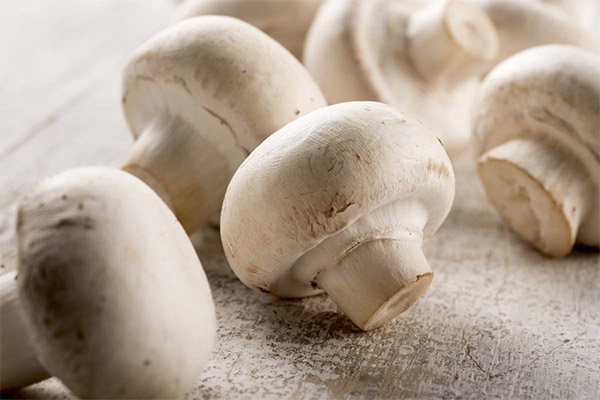
Champignons begin to grow actively from May to almost mid-autumn. They are common on the European continent in temperate latitudes. These are quite strong mushrooms, since they can develop pressure of 7 atmospheres, which helps them to break through solid soil.
Kinds
The main types of champignons:
- Coppice. Mushrooms live in forest areas. The diameter of the cap is 5–10 cm; the color is light gray. The length of the leg is 7–9 cm, the thickness is up to 1 cm, it has a cylindrical shape, light color, and a light yellowish ring. The pulp has an anise smell. Thin, frequent plates can be pinkish, lilac or brown.
- Yellow skin. Mushrooms are poisonous, usually grow among grass on fertile soil. They can often be found in a park, in a field, or even near housing. The diameter of the cap is 7–15 cm, has a hemispherical shape, concave edges. Later, the shape becomes flat round, prostrate, sometimes with a convex center. The light hat may turn yellow and become brown or brownish spots. The length of the leg is about 7 cm, the thickness is 1-2 cm, the ring is double. The light flesh turns yellow after the cut, has an ink smell. Frequent light or pink-gray plates can acquire a coffee-milk and purple color.
- Reddish. They grow in areas of mixed forests and parks. The diameter of the hat is 5–10 cm, it has a spherical shape, later convex. The hat is light with a reddish or brown center. The length of the leg is 5–10 cm, the thickness is 7–15 mm, it has a white color and a pinkish ring. Light flesh has a nutty flavor. Frequent plates during the growth period are transformed from pinkish to brownish, purple.
- Rose plate. They are found in forests, parks and near housing. The diameter of the hat is 4–8 cm, the color is light brown or light, the plates are pink, the shape is spherical or bell-shaped, the edges are concave. The height of the smooth, hollow leg is 3–7 cm, the thickness is 3–9 mm, and the ring is white. Light flesh may have a yellow tint.
Pale toadstool and champignons: similarities and differences
Similarities: Both fungi have almost the same size. The height of the stalk is on average 10–15 cm. The diameter of the cap is about 15 cm. The mushrooms also have similar rings located on the stalk.
Differences:
- One of the differences is the size of the base of the mushrooms. Inedible species have a thin, soft leg; in edible champignon, it is denser and thicker.
- Mushrooms can also be distinguished by the color of the caps. In grebes, it is lighter both above and below, in contrast to the cap of edible mushrooms, the lower part of which has a pinkish color. A toad cap can sometimes change color from white to light green.
- Mushrooms can also be distinguished by smell. Inedibles have no smell at all, while edible ones have a slightly almond aroma.
- Worms do not spoil the pulp of grebes. Edible mushrooms may have traces of the presence of worms.
Composition and calorie content
100 g of product contain:
- calories - 27 kcal;
- proteins - 4.3 g;
- fats - 1 g;
- carbohydrates - 0.1 g.
In addition, the product contains vitamins of groups B, D, E, PP. Mushrooms are also rich in calcium, potassium, selenium, zinc, copper, manganese, phosphorus, iron and essential amino acids.
What are the benefits of champignons
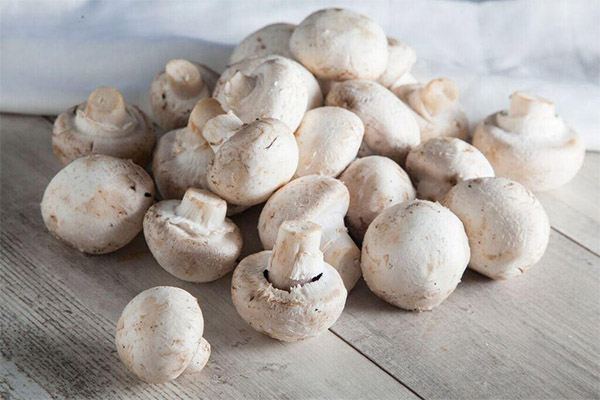
General benefit
- They are a source of selenium. In champignons, this substance is quite a lot. Selenium has antitumor, antioxidant and anti-inflammatory potential and can reduce the risk of cancer, thyroid disease, affect cognitive function.
- Regulate cholesterol. Mushrooms provide the body with high-quality proteins, while they practically do not contain fats and carbohydrates. Fiber along with enzymes helps regulate cholesterol in the body. In addition to controlling cholesterol, the substances contained in champignons help to get rid of it during the digestion of food. A balance between cholesterol levels between LDL (bad cholesterol) and HDL (good cholesterol) is needed to prevent cardiovascular disease, atherosclerosis, heart attacks, and stroke.
- Maintain bone health. This type of mushroom is an excellent source of calcium. This is an important nutrient involved in the formation and strengthening of bone tissue. The constant intake of calcium in the body will have a beneficial effect on the general condition and will help reduce the risks of developing osteoporosis, as well as reduce joint pain, improve their motor ability and prevent bone degradation.
- They are a source of vitamin D. This substance, which is not so often found in food, so its presence in food makes it automatically more valuable. This vitamin is present in champignons and helps the body absorb calcium and phosphorus better, normalizes the general metabolism. Calcium and phosphorus are also present in mushrooms in sufficient quantities, so the combined effect of all these nutrients makes this product especially valuable for health.
- Strengthen the immune system. Ergotionine is a powerful antioxidant present in champignons, acts as a defender of the body from the influence of free radicals and helps strengthen the immune system. Ergotionein destroys free radicals - dangerous compounds that are released during metabolic processes and move throughout the body, causing significant damage to it, leading to various diseases. Mushrooms contain natural antibiotics that inhibit the growth of germs and fungal infections. The polysaccharides contained in champignons stimulate and regulate the processes associated with the functioning of the immune system.
- Normalize blood pressure. Champignons, among other things, contain potassium. Potassium can act as a vasodilator. It helps relieve tension from blood vessels and, therefore, helps to lower blood pressure. High blood pressure has a negative effect on the body, as it provokes the occurrence of heart attacks and strokes. Potassium also improves cognitive function, as an increase in the flow of blood and oxygen to the brain stimulates nervous activity. Studies have shown that a sufficient amount of potassium in the body improves memory.
- Improve the digestibility of iron. Copper contained in champignons also has a beneficial effect on the body. Copper deficiency can lead to anemia or neutropenia. This is due to the fact that copper regulates and stimulates the absorption of iron. In addition, the mushrooms contain a sufficient amount of iron, so the symbiosis of these substances even more effectively helps maintain healthy bones and prevents the occurrence of anemia.
- Prevent cancer. Champignons contain compounds that help reduce the risks of certain types of cancer. For example, lectin helps to slow the growth, development and spread of cancer cells. Women who regularly consume champignons are less likely to develop oncology than those who do not have these mushrooms in their diets.
- Maintain healthy skin and hair. Nutrients (selenium, copper, biotin, niacin and riboflavin) contained in champignons help maintain healthy skin and hair.
For women
Champignons have a beneficial effect on the female body. Regular consumption of mushrooms can significantly reduce the risk of cancer. In addition, it was found that mushrooms can prevent early aging, the appearance of wrinkles, and this product also supports a healthy complexion. Mushrooms contain powerful antioxidants - selenium, often used as one of the main components of anti-aging cosmetics, as well as pantothenic acid, which has the properties of skin cell restoration.
For men
With a small number of calories, champignons have practically no fat, so they very effectively help lose weight and gain muscle mass. Sometimes you can even replace mushrooms with meat, as the product is rich in fiber and protein. In addition, selenium is present in champignons - an ally of the body in the fight against prostate cancer. Diets rich in potassium with a low sodium content reduce the risks of the occurrence and development of cardiovascular diseases. Adding mushrooms to the diet can have a beneficial effect on the reproductive system. Champignons help inhibit estrogen production and contain enzymes that help maintain high testosterone levels.
During pregnancy
It is not recommended to use mushrooms during pregnancy, but in case of strong desire it is allowed to eat a small portion of store mushrooms. They have a number of useful properties that positively affect the health of the expectant mother. Mushrooms can provide the body with vitamins D, B, iron, protein, fiber and antioxidants, which are necessary for a woman and a growing fetus. It is worth noting that improper cooking of mushrooms can harm a woman in position.
When breastfeeding
Champignon is a diet product. It practically does not contain fats and sugars, but it contains vitamins and minerals that the body needs during breastfeeding. These are zinc, potassium, iron, iodine and phosphorus, vitamins of groups B, C, D and E. Thiamine reduces the likelihood of headaches that women can suffer in the postpartum period, and riboflavin supports the normal functioning of the liver and is involved in blood formation processes. Amino acids (lysine and arginine) regulate blood pressure, participate in the production of growth hormone, support brain activity, metabolism and contribute to more efficient removal of toxins from the body. In the postpartum period, light food should be preferred. Mushrooms can be boiled or stewed, but they can not be pickled and fried, since fats and acids can have a negative effect on the body of the mother and child.
You can introduce mushrooms into your diet when the child is 4 months old. In case of problems with the liver or gall bladder, you should refuse to use this product.
For kids
Since mushrooms are not a very digestible food, many find this product unsuitable for children.Beneficial substances are mostly found in the cap of the fungus, while components that can harm the body of the child are more present in the leg. In addition, if we talk about forest mushrooms, they often can contain hazardous substances obtained from the soil, so it is recommended that children give only a store-bought product. Do not include mushrooms in the diet until the child is 5 years old.
Can I eat champignons when losing weight
Champignons are often used as an ingredient in diet foods. This product is used both in the period of active weight loss and in the unloading period, since it practically does not contain calories, fats and carbohydrates.
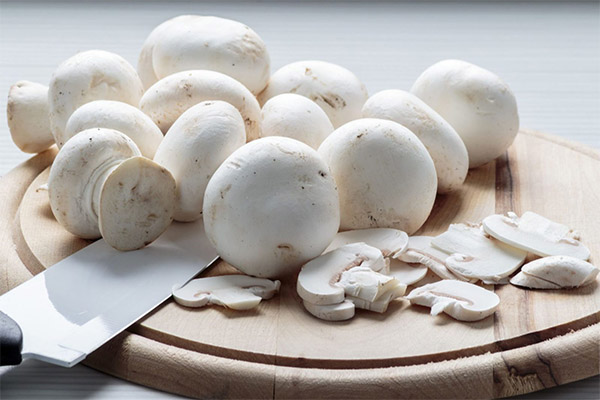
Champignons support the figure, since they are more than 85% liquid. With a small amount of fat, they can pretty well satisfy your hunger. The protein found in mushrooms is great for burning fat. With the daily use of mushroom dishes, you can effortlessly lose a few pounds. And if, after losing excess weight, you need to keep fit and record the result, then regular consumption of champignons will greatly help in this. Plant fibers are involved in metabolic processes and give a feeling of satiety. Champignons also give energy. For effective weight loss, it is better to use a fresh product or boiled product.
Champignon mushrooms in medicine
In the field of traditional medicine, various mushroom tinctures and extracts are quite popular, which help fight ulcers and promote wound healing. In addition, they can be used as an ingredient in cosmetics and face masks. In the field of traditional medicine, champignons are not used. Mushrooms can only act as permitted or prohibited products.
With diabetes
Champignons are considered very suitable food for diabetics. They have no fats, cholesterol, very low carbohydrates and high protein content. In addition, they contain a lot of water and dietary fiber. It is worth focusing on the fact that the composition of this product contains natural insulin, as well as enzymes that help in the breakdown of sugar.
It is also known that fungi contain compounds that support the normal functioning of the liver, pancreas and other endocrine glands, thereby contributing to the formation of insulin and its proper regulation throughout the body. Natural antibiotics in champignons can help protect the body in diabetes from potentially life-threatening conditions.
Important: the glycemic index of champignons - 15 units.
With pancreatitis
In case of exacerbation, it is forbidden to consume mushrooms, since the substances contained in them are very difficult to digest, which leads to bloating and painful cramps. In addition, the absorption of many beneficial substances, including proteins, is difficult. There is also a secretion of pancreatic enzymes and gastric juice is produced, which can trigger pain attacks, nausea and vomiting.
With persistent remission, champignons are also prohibited. But if there is a great desire, then you can include this product in your diet, but you need to adhere to recommendations that will minimize negative consequences. You can start eating mushrooms after a year has passed after the acute phase of the disease, and only in the case of a mild illness. You need to use cultured store mushrooms. At the first dose, do not eat more than 1 teaspoon. After use, you need to monitor your condition and in case of side effects, exclude the product from the menu. At a time, you can eat no more than 2-3 mushrooms (1 time in 2 weeks). Rinse the mushrooms well before cooking. A safe option is considered to be boiled and crushed to the consistency of mashed champignons. It is not allowed to fry and pickle mushrooms.
With gastritis
With gastritis, eating this type of mushroom is prohibited. The main reason for the ban is that in case of such diseases, indigestible products, including champignons, are contraindicated in the body. In addition, you can not eat mushrooms of this type, because:
- They contain a lot of chitin. Chitin is a hard-to-digest substance that can provoke a weakening of the digestibility of other substances, so the overall benefit of the product can be completely nullified.
- Due to severe digestion, stimulation of the production of gastric juice is intensified, and this in turn can lead to an exacerbation of the disease.
- Mushrooms absorb toxins and radioactive substances from the environment during their growth. Given that many areas today are contaminated with industrial waste, it can be concluded that most fungi potentially pose a threat to a healthy person. In this case, the threat increases in case of gastritis.
It is worth noting that there are exceptions to this issue. With a strong desire, people in the case of sustained prolonged remission can use small mushroom broths in small quantities. It is important to remember that mushrooms must be removed from the prepared broth, this will help reduce their harmful effect. If we talk about fried champignons, then they are strictly forbidden to eat. If you still decide to eat mushroom broth, then before this you should drink a preparation for the stomach 30 minutes before eating. This will help the food to be better absorbed, prevent the occurrence of heaviness after eating.
With gout
Champignons are a tasty and low-calorie product, but, unfortunately, people who suffer from gout should be very limited in their consumption. Champignons increase the number of uric acid crystals in the joints. In addition, fresh banned mushrooms contain other prohibited substances, so they are not recommended for use with gout. Mushroom soups, sauces and broths can trigger an exacerbation of the disease.
With cholecystitis
With cholecystitis, it is forbidden to eat any kind of mushroom, including champignons. In addition, it is not allowed to use mushroom-based broths, as this can adversely affect the course of the disease, and in some cases provoke an exacerbation.
Harm and contraindications
Mushrooms are mushrooms that can have a negative effect on the body and even seriously harm health. They contain a large amount of chitin - a component that is rather difficult to digest, especially when it comes to the children's body. In addition, chitin also affects the processes associated with the absorption of nutrients that are present in mushrooms.
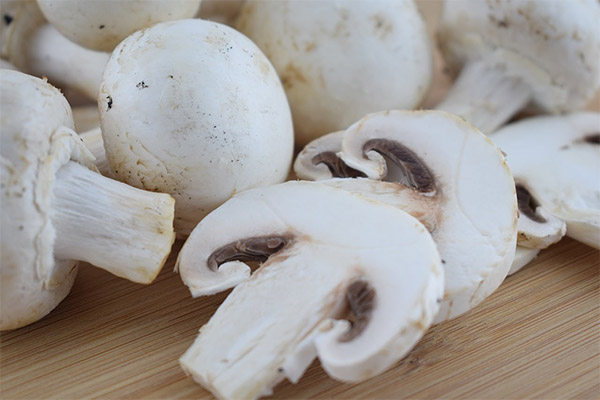
Another point worth paying attention to is the habitat of the mushrooms during their active development. This is important because mushrooms absorb all of the toxins that are in the soil or in the air. It is also worth noting that with excessive use of this product, various inflammation in the digestive tract can occur.
Is it possible to poison mushrooms
Champignons, like other types of mushrooms, can be poisoned. Poisoning is often very dangerous, sometimes it can cause serious health problems, even death. It is recommended to purchase the product only in the store, while it is important to pay attention to quality. Rinse the mushrooms thoroughly before use.
Symptoms
Symptoms of champignon poisoning:
- cold sweat;
- headaches, dizziness;
- nausea, vomiting;
- apathy, weakness in the body;
- hallucinations;
- yellow skin tone;
- diarrhea;
- blurred vision;
- acute cramping and abdominal pain.
How to choose and store champignons
When choosing champignons, first of all, you need to pay attention to their color. Fresh product will have a white-brownish or completely white color. Lighter mushrooms will be stored longer, and they will also be able to better retain their beneficial properties. It is recommended to choose mushrooms with a sealed, intact film that connects the leg to the hat.
Mushrooms can be stored for about 5 days (in the refrigerator). Mushrooms should be checked periodically during storage, as they can become wet and slippery. In case the champignon has opened and darkened in the inside, it must be used as soon as possible.
Is it possible to freeze
Mushrooms can be frozen. Since mushrooms are a perishable product, they should be used as soon as possible after purchase. If this is not done, then the mushrooms can darken and quickly become inedible. But sometimes it happens that the purchased mushrooms need to be left for some time to preserve. In this case, they can be frozen, the main thing is not to wash them before placing them in the freezer, so that they do not absorb liquid.
How to cook champignons: recipes
Champignons are widely used in the field of cooking. Mushrooms can be used as an ingredient in various dishes. They can give great taste to soup, salad, sauce, souffle, gravy and even pie. Mushrooms can be eaten fried, stewed, pickled, boiled, dried and baked. Champignons go well with fish and meat, seafood, various cereals, as well as vegetables and eggs.
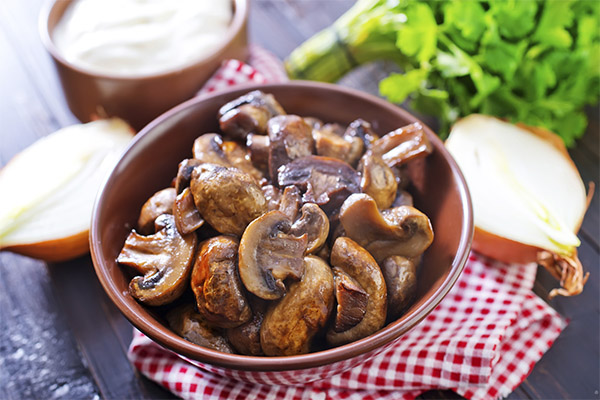
It is not recommended to use them with dairy products or nuts. In addition, champignons should not be mixed with potatoes, as this can lead to digestive problems.
How to fry
Ingredients:
- champignons - 550 g;
- onions (onions) - 1 pc.;
- oil (vegetable) - 50 g.
How to cook:
- Peel the mushroom pulp under the hat, remove dirt and black spots from the product. In a colander, quickly rinse the mushrooms, wait until the water drains.
- Cut champignons into large pieces.
- Chop onions (rings into 4 parts).
- Heat a skillet over medium heat using vegetable oil. Strain until the onion is golden (about 2 minutes).
- Put the mushrooms in a pan, pepper, salt (for personal taste) and mix. Fry over medium heat, stirring occasionally.
- Fry for about 10 minutes until all moisture has evaporated. After that, leave to fry for another 3 minutes, so that the mushrooms acquire a blush.
- At the end, you can add a clove of garlic (optional).
How to boil
For boiling champignons, you can use a pot or stewpan.
- Pour water into the selected container. Water needs so much that after adding mushrooms, it can completely cover them.
- Put water on fire, salt. Peel the mushrooms and cut them into 2–4 parts.
- Put the mushrooms in boiling water. After boiling, the fire must be reduced and carefully, slowly, put the mushrooms in a pan, then cover the container.
- Wait for boiling, reduce heat and continue cooking, periodically removing foam.
- After cooking, strain the mushrooms with a colander.
Mushrooms should be cooked for about 5 minutes (count from the moment of boiling water with mushrooms).
Champignon mushroom caviar
Ingredients:
- champignons - 500 g;
- carrots - 1 pc.;
- onion - 1 pc.;
- vinegar - 1 tbsp. l
How to cook:
- Rinse the mushrooms well and allow to dry. Then cut them into slices.
- Peel the onions and carrots. Rub the carrots on a grater (finely).
- Cut the onion into half rings or cubes.
- Pour oil into a pan and put on a stove over a slow fire.Put onion with carrot on it.
- When the vegetables soften (after 8-10 minutes), put the mushrooms in a pan and mix.
- Salt, pepper (add spices and bay leaf if desired).
- Start frying the mushrooms (about 10 minutes), stirring occasionally.
- Remove the mushrooms from the stove and let them cool (remove the bay leaf). Transfer the mushrooms into a bowl (deep), leave the excess liquid in a pan.
- Kill the fried mushrooms with a hand blender until gruel.
For better storage, you can add table vinegar to the caviar. Place caviar in a jar, close the lid, and store in the refrigerator.
Champignon barbecue
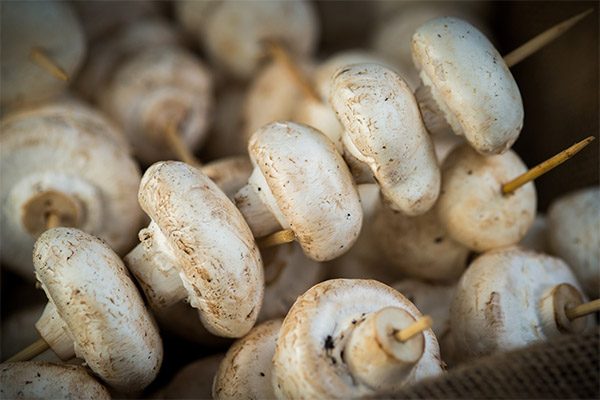
Ingredients:
- champignons - 300 g;
- oil (vegetable) - 2 tbsp;
- soy sauce - 2 tbsp .;
- lemon juice - 1 tsp;
- paprika (sweet) - 0.5 tsp
How to cook:
- Rinse and wipe the mushrooms dry, put them in a plastic bag. Add chopped dill, paprika and 1 head of garlic (chopped) there.
- Pour soy sauce, oil and lemon juice directly into the bag.
- Tie a bag and shake it well. After that, leave it for 12-15 minutes.
- Then string the mushrooms on skewers.
- Preheat the oven to 210–230C. Place the strung mushrooms in it and bake for about 15 minutes. After that, the dish can be served.
How to cook mushrooms in the oven
Ingredients:
- champignons - 1 kg;
- mayonnaise - 3 tbsp;
- salt - 1 tbsp;
- pepper (black) - 0.3 tsp;
- mustard - 1 tsp
How to cook:
- Rinse the mushrooms, wait until the water drains. Mix all the ingredients and put them in a bowl of champignons.
- Mix well and marinate for 1 hour.
- Put the mushrooms on a baking sheet (covered with foil) so that the legs are at the top.
- Put in a preheated oven to 200C for 30 minutes.
- After cooking, sprinkle the mushrooms with garlic (chopped) or herbs.
How to cook champignon soup
Ingredients:
- water - 1.5 l;
- champignons - 5 pcs.;
- potatoes - 2 pcs.;
- carrots - 1 pc.;
- onion - 1 pc.;
- oil (vegetable) - 2 tbsp.
How to cook:
- Cut carrots (straws) and chop onions.
- Place vegetables in a saucepan and fry in oil.
- Coarsely chopped mushrooms add to the bowl and fry (about 3 minutes).
- Peeled and diced potatoes put in a pan, pour boiling water and put on fire.
- When the soup is ready, salt it, and you can also put greens.
How to pickle
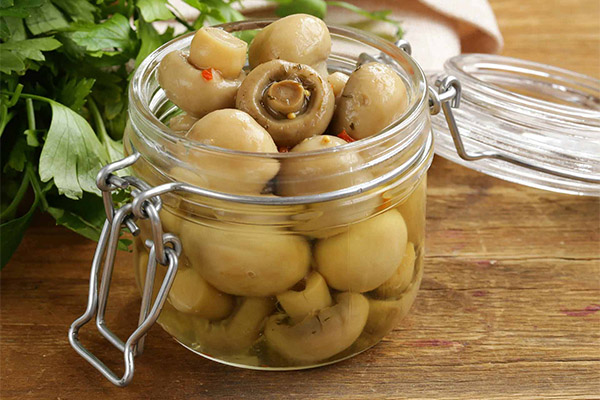
Ingredients:
- champignons - 500 g;
- water - 50 ml;
- vegetable oil (refined) - 50 ml;
- garlic - 3 teeth .;
- vinegar - 2 tablespoons (5%);
- bay leaf - 2 pcs.;
- sugar - 1 tsp
How to cook:
- Pour water into the pan. Then salt and pepper add vinegar, bay leaf, sugar, garlic, as well as oil.
- Place the washed champignons in a pan, put on a boil over medium heat. After boiling, boil for 5 minutes.
- Remove the mushrooms from the heat, let them cool, after which it is already possible to serve.
Do I need to clean the mushrooms before cooking
Many people believe that it is not necessary to peel the mushrooms, because even in restaurants they are sometimes served unpeeled. Sometimes unpeeled champignons are acceptable for cooking, but in any case, they must at least be wiped with a wet towel or towel. In general, it is highly recommended to wash the mushrooms well. Rinsing will be the best option, since unwashed mushrooms can carry a rather serious danger to humans.
How to eat champignons
Mushrooms can be consumed raw, fried, stewed, boiled, the most important thing is that the product is of high quality. It is advisable to buy them at the supermarket and at the same time make sure that the product does not have external flaws.
Is it possible to eat darkened
It is important to determine the nature of the darkening of the fungi. If the darkening appeared on the mushroom's head, but the color remains normal during a break inside, then such a product is acceptable.If the plates in the lower part are dense and slightly darkened, then they can also be prepared. And if the plates have a saturated dark color and at the same time they are slightly wet and mucilous, then it is better not to eat such mushrooms.
Is it possible to eat raw
If we talk about greenhouse mushrooms, then they can be eaten raw, which cannot be said about forest mushrooms. They very often accumulate toxins harmful to the body.
Is it possible to give champignon mushrooms to animals
Mushrooms are not digested in the stomach in animals. This is a rather heavy product, so it is not recommended to give it to pets. In addition, mushrooms can cause poisoning or cause digestive disorders. It is better not to take risks and not to offer animals mushrooms or dishes based on them, since this product is not natural for them. It is not known what effect it will have on their bodies.
Interesting facts about champignons
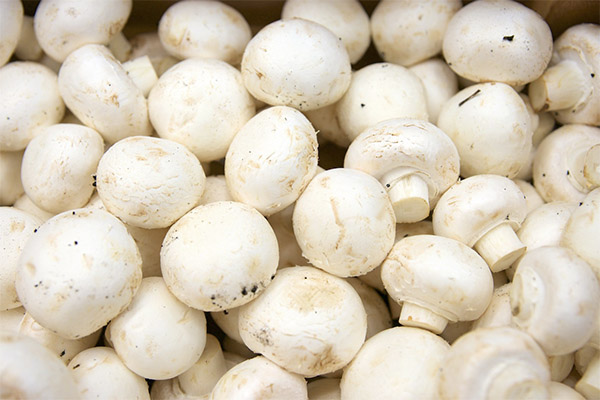
- Champignons were first discovered about a thousand years ago. According to research, the first to use them were the inhabitants of Italy, eating them with food, and only later they began to grow. Champignons are considered almost the first mushrooms that began to be grown in an unnatural environment.
- Mushrooms gained popularity throughout Europe only in the 18th century. In addition, in the capital of France, champignons were once considered a delicacy delicacy, so this product was quite expensive.
- Some kings living on the European continent had special cellars, equipped with rooms for growing and cultivating a special kind of champignons, which were intended only for high ranks.
- Champignons are so popular mushrooms that they are used even in those countries where such a product is not held in high esteem.
- The largest exporters of champignons are the USA, France and Great Britain, while they have gained the greatest popularity in Poland.
- The product is quite widely used in the field of medicine. Mushrooms can help with diseases such as bronchitis and diabetes. Also, the substances contained in them can relieve headaches, treat hepatitis and tuberculosis. In addition, on the basis of mushrooms, various hoods can be made that are very effective for skin problems.
- Champignons are also widely used in the field of cosmetology. In some countries there are beauty salons offering various masks, creams, lotions and other beauty products, in which the main ingredient is champignon. Such cosmetics are usually quite expensive.
«Important: all information on the site is provided exclusively in fact-finding purposes. Before applying any recommendations, consult with a profile specialist. Neither the editors nor the authors are liable for any possible harm caused materials. "

